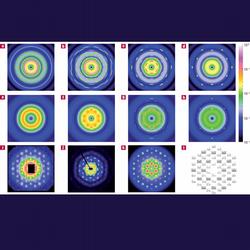Evolution of Debye–Scherrer rings into Bragg peaks with increasing order. (j) SAXS patterns of a lyotropic f.c.c. phase, measured at beamline BW4 at DORIS III. Detailed description (link to paper) (Credit: Nature Materials 2007)
Scientists from the Institute of Physical Chemistry of the University of Hamburg, the Institut-Laue-Langevin ILL, Grenoble and their collaborators from DESY performed measurement at DORIS III and at the neutron source and calculated diffraction patterns. They showed that for peak widths generally observed for soft materials each set of primary Bragg peaks is accompanied by a set of secondary Bragg peaks.
Highly ordered soft materials exhibit Bragg peaks that cannot be indexed assuming homogeneous crystal structures. Their origin has been attributed to changes in the crystal structure that are induced by the ordering process such as by application of external fields. This would restrict the use for the generation of highly ordered nano- and microstructured materials where a homogeneous crystal structure is an important key requirement.
They demonstrate that these Bragg peaks are an inherent property of homogeneous ordered soft materials related to the finite coherence of their crystalline lattice. This is shown by a combination of scattering experiments (neutron and synchrotron X-ray diffraction), direct imaging (scanning electron microscopy, SEM) and model calculations. The obtained result allows a detailed and quantitative analysis of the diffraction patterns of materials such as lyotropic liquid-crystalline phases, mesoporous materials, colloidal dispersions, block copolymers, electrorheological fluids and photonic crystals. It further enables the researcher to develop a concise picture of order, line density, field-induced orientation and epitaxial relations for soft-material lattices.
Their results were published online in Nature Materials (26 August 2007).
(from: ...Paper and Webpages)
| Further Links |
|






